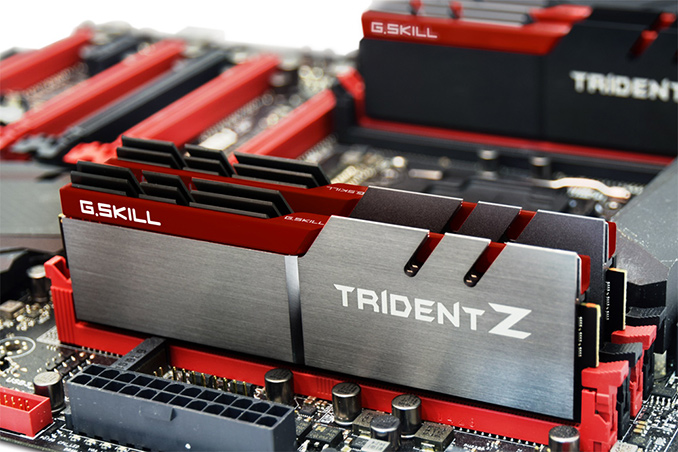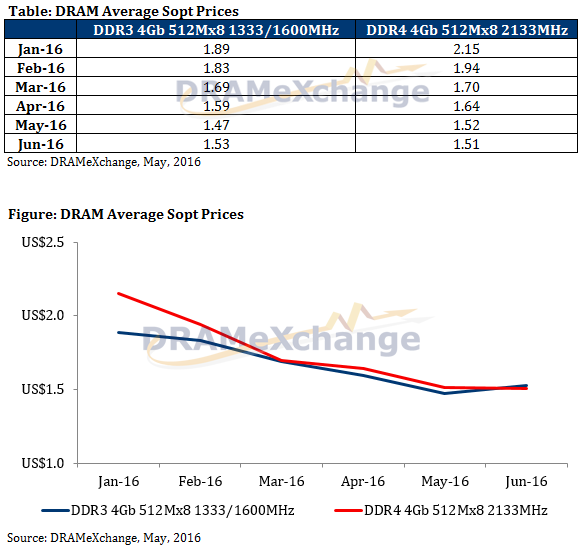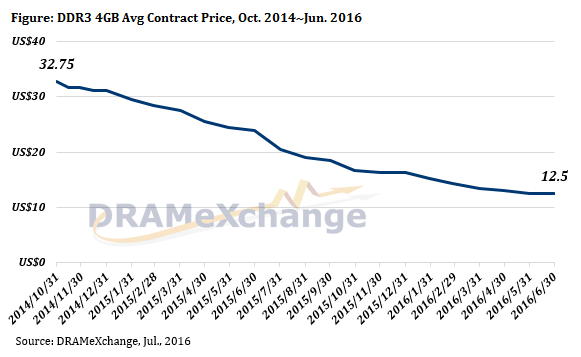Price Check Q3 2016: DRAM Prices Down Over 20% Since Early 2016
by Anton Shilov on July 25, 2016 12:01 AM EST
Slow sales in the first half of 2016 have negatively affected suppliers of virtually all of PCs, tablets and smartphone components. Producers of DRAM typically suffer more than others when it comes to pricing, since computer memory is considered a commodity and its quotes mostly depend on supply and demand rather than on technology advantages. Since early 2016, prices of DDR3 and DDR4 chips have declined by over 20%, according to DRAMeXchange (a division of TrendForce that tracks DRAM market). Despite the fact that it is slightly costlier to produce DDR4 memory because of slightly larger die sizes, at times the physical DDR4 modules can actually be cheaper than DDR3 ones. Since producers like Micron, Samsung and SK Hynix are not happy with the current situation on the market, observers have reported that the big three intend to implement a plan to control supply.
DDR3 Vs. DDR4: Crossover Is Nearing
The average spot price of one 4 Gb DDR4-2133 memory chip was $1.751 in late-July, according to DRAMeXchange (most information in this piece is from this source unless otherwise stated). For comparison, in Feb '16 the equivalent chip was $1.814. Going back further, in Dec '15 they were $2.221, and in late June '15 up at $3.618.
As it turns out, a 4 Gb DDR4-2133 memory IC (integrated circuit) is nearly 50% cheaper in the last 13 months and around 22% cheaper since the start of the year. The average contract price of a DDR4-2133 DRAM chip was $1.31 in the second half of June, down from $1.63 in the second half of January. Meanwhile, in the recent months DRAMeXchange has begun to track spot prices of 8 Gb DDR4-2133 chips. Right now one chip costs $3.633 on average, down from $4.688 in mid-April.
Spot prices of DDR3 memory are dropping fast as well. A 4 Gb DDR3-1600 memory IC costs $1.675 in Taiwan, down from $1.878 in December and $2.658 in late June '15. In about a year, a 4 Gb DDR3 chip is 37% cheaper, mainly due to slow demand for electronics. 8 Gb DDR3-1600 memory chips are considerably more expensive than DDR4 chips of the same capacity, also tied to demand. At the time of writing (7/22/16), one of such chips cost $4.96.
Right now, the spot price of 4 Gb DDR4 memory chips is a little higher than the price of 4 Gb DDR3 DRAM ICs. The gap is only around three cents, but still volatile and we would not make any definitive conclusions at this point as to the reasons why. Back in June, DDR4 chips were cheaper than DDR3 ICs (in fact, they were slightly cheaper than DDR3 chips throughout the whole month) and we observed a similar situation in March, but eventually DDR4 regained its price advantage over its predecessor because the demand for such type of DRAM has grown as Intel is ramping up its DDR4-supporting platforms. It is unclear whether leading DRAM IC producers are now deliberately making more DDR4 chips, such that the supply of such memory exceeds demand. If this is the case, then we are observing the inevitable DDR3/DDR4 price crossover point. If this is not, then, DDR4 will regain its price premium over DDR3 in the coming weeks because more systems are adopting the newer type of memory.
It should be obvious that prices of DRAM ICs directly affect the prices of actual memory modules used by PC makers. In the second half of April '16, one 4 GB DDR4-2133 SO-DIMM was priced at $13 on contract basis, down from $15.50 in the second half of January. Meanwhile, the contract price of one 4 GB DDR3-1600 SO-DIMM dropped to $12.50 (down from $15.25 in January, 2016).
It is noteworthy that starting from early June prices of DDR3 and DDR4 memory have been slowly increasing. Market observers believe that this is happening because DRAM makers are switching to production of server-class and LPDDR memory, reducing supply of commodity DRAMs ahead of the back-to-school season. Nonetheless, it should be observed that in the last couple of years nothing could stop memory prices from coming down. At various times it looked like they had stabilized or even increased, but in the end, they just continued their slump.
Now, let’s take a look what is going on in the U.S. retail.












37 Comments
View All Comments
invasmani - Monday, July 25, 2016 - link
The majority of American's that actively live in the northern states most impacted by the Keystone pipeline deal were in favor of it. It's the fault of Obama and democrats who tried to make it into a big environmental issue despite the fact that a pipeline is much safer than railroad transport.catboy - Tuesday, July 26, 2016 - link
tipoo is correct. Corporations scam Canadians with outrageously unfair prices just because they can. Here is a news report about that fact:http://www.cbc.ca/news/canada/country-pricing-a-ca...
Of course, that report is not about hardware, but Canadians get price gouged on hardware in the same way as they do on all other products.
I recommend for Canadians to stop buying products from Canadian sellers whenever possible. If enough Canadians do that, then corporations will end the practice of price gouging Canadians.
doggface - Tuesday, July 26, 2016 - link
Same thing happens in Australia. $160 in USD = $350-$400 in AUD.The manufacturers price items much lower in the US to get the buzz from websites like these. Then mark it up in lower volume countries.
Another example. $US600 for GTX1080 = $AUD1150
Sure. Our dollar is lower. But it doesnt account for the massive discrepency. We call it the Australia tax
Arnulf - Monday, July 25, 2016 - link
I find it intriguing that Samsung has been producing complex circuits on 14 nm node for some time now yet they are only switching to 18 nm for DRAM production (which should be more dense).DanNeely - Monday, July 25, 2016 - link
Somewhere around half a DRAM die is made up of analog components used to terminate signals on the database; and unlike the digital circuits in the ram cells themselves analog components scale minimally with process shrinks. As a result DRAM gets less of a benefit from process improvements than things like CPUs/GPUs/Flash that are almost all digital components on the die. The analog penalty has gotten worse with each new generation of DDR because to keep the data bus stable at higher frequencies the termination components need to be moved closer to the DRAM; leading to a steady migration of them from the mobo to the dimm to the dram chips themselves.p1esk - Monday, July 25, 2016 - link
Source? Everything is analog of the circuit level.DanNeely - Monday, July 25, 2016 - link
It was something I read back when the DDR4 spec was first released so I'm having trouble finding it (will look more later); but analog components are things that aren't transistors eg resistors, capacitors, inductors (also power transistors which need to be a certain size to carry the amount of current that they do or a lot of RF components; but neither of them are a factor here). Physical size is a major component in how they perform. ex Make a capacitor half as large and all other things equal it's capacitance is only half as great.It's one of the factors behind why the minimum size dimm goes up every time there's a new process. The lower capacity dram chips see the least shrinkage because the largest fraction of their die is signal termination components that don't shrink much.
yuhong - Tuesday, July 26, 2016 - link
I guess that is why they often eventually drop things like x4 configurations when moving older DRAM like 1Gbit DDR2 to newer processes.jardows2 - Monday, July 25, 2016 - link
I built my current computer in 2102, and purchased 8 (2x4) gigs of DDR3-1600 RAM. Thinking I could eventually upgrade to 16 gigs if needed, but then memory prices shot up. I can finally purchase the same RAM I did 4 years ago at a slightly lower price, instead of a significantly higher (at times was double what I paid) price!bananaforscale - Monday, July 25, 2016 - link
I built mine in late 2011 and bought 4x4 GB of DDR3-1600. Decided to upgrade the memory past winter, the price per GB was still about the same for the DIMMs I used, but doubling the amount and buying faster memory wasn't that much more expensive -> went from 16 GB 1600 to 32 GB 2133 (except the CPU only supports 1866 but whatevs) and distributed the old memory among less important hardware.